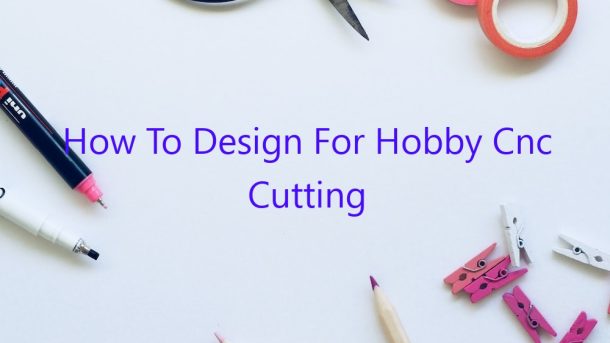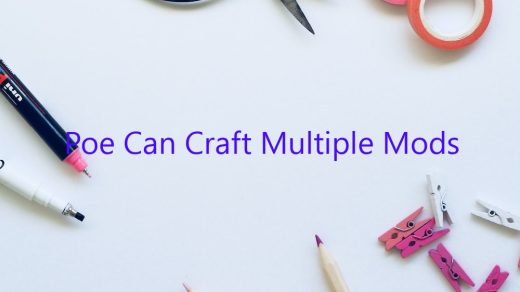CNC routers are used extensively in industrial applications for cutting and shaping materials. Hobbyists can also use CNC routers to create projects, however, the process of designing for hobby CNC cutting is different from designing for industrial applications. In this article, we will discuss the basics of designing for hobby CNC cutting.
The first step in designing for hobby CNC cutting is to determine the size and shape of the project. It is important to keep the project size and shape within the capabilities of the CNC router. The next step is to determine the type of material that will be used for the project. The material must be compatible with the CNC router and the type of cutting that will be used.
Once the size, shape, and material of the project have been determined, the next step is to create the design. The design must be created in a CAD (Computer Aided Design) software program. The design must be broken down into the individual parts that will be cut. Each part must be designed with the correct dimensions and cut paths.
Once the design is complete, the next step is to create the cutting files. The cutting files must be in the correct format for the CNC router. The most common format for CNC routers is G-code. The cutting files must also be checked to ensure that they are error-free.
The final step is to load the cutting files into the CNC router and start the cutting process.
Contents
How do you design something for a CNC machine?
Designing something for a CNC machine can seem daunting at first, but with a few simple tips it can be easy to create a file that will result in a perfectly machined part.
The first step is to create a CAD file of your design. CAD software is designed to help you create precisely-drawn 3D models, which is essential for CNC machining. In order to create a file that is easy to machine, it is important to keep a few things in mind:
-Keep your design simple. Complex designs can be difficult to machine and may result in poor-quality parts.
-Make sure all of your dimensions are accurate. CNC machines work by moving a cutting tool around a fixed workpiece, so any inaccuracies in your design will be magnified.
-Avoid undercuts and sharp corners. These can be difficult to machine and may lead to poor-quality parts.
Once your CAD file is complete, you can export it as a G-code file. This is the file that will be used to control the CNC machine. There are a number of software programs that can convert CAD files to G-code, but most CNC machines come with their own software that will do the job.
Once your file is ready, you can send it to the CNC machine. The machine will then use the G-code to create your part.
What are the basic rules of design in CNC machine parts?
There are a few basic principles of design that should be followed when machining parts on a CNC machine. The following tips will help to ensure that your parts are properly machined and fit together properly.
1. Design your parts with the end use in mind.
When designing parts for a CNC machine, it is important to think about how the part will be used. Will it be used in a mechanical assembly or as part of a larger system? What are the tolerances that will be needed? Will the part need to be machined from a single piece of stock or can it be made from multiple pieces? Thinking through these questions before you start designing will help to ensure that your parts are designed properly and will function as intended.
2. Use standard features and sizes whenever possible.
When designing parts, it is best to use standard features and sizes whenever possible. This will help to ensure that the parts will fit together properly and will be easier to machine. If you need to create a custom feature or size, try to keep it as simple as possible.
3. Use a consistent units of measurement throughout your design.
It is important to use a consistent units of measurement throughout your design. This will help to ensure that all of the dimensions are accurate and that the parts will fit together properly.
4. Avoid tight tolerances whenever possible.
Tight tolerances can be difficult to machine and can lead to parts that are difficult to assemble. It is usually best to avoid tight tolerances whenever possible. If you do need to use tight tolerances, make sure that the part can be machined accurately and that the tolerances are clearly specified in the design.
5. Draw your parts to scale.
When designing parts, it is important to draw them to scale. This will help to ensure that the dimensions are accurate and that the parts will fit together properly.
6. Use a standard drafting notation.
When drafting your designs, it is best to use a standard notation. This will help to ensure that all of the dimensions are clear and that the parts will be easy to interpret.
7. Check your designs for errors.
It is important to check your designs for errors before submitting them for machining. This will help to ensure that the parts will be machined correctly and that the finished parts will be correct.
Which design software is best for CNC programming?
There are a number of different design software programs that are available for CNC programming. In order to find the best software for your needs, you need to consider the type of CNC machine that you are using, the level of complexity of the designs that you need to create, and your level of experience with computer-aided design (CAD) programs.
One of the most popular design software programs for CNC programming is SolidWorks. It is a comprehensive program that can be used to create complex 3D designs. SolidWorks also has a large user community, so there is plenty of online support available if you need it.
Another popular program for CNC programming is AutoCAD. AutoCAD is a widely used CAD program that is available in both a desktop and a cloud-based version. It is a versatile program that can be used to create 2D and 3D designs.
If you are looking for a free CAD program, Inkscape is a good option. It is a fairly basic program, but it can be used to create simple 2D designs.
When choosing a design software program for CNC programming, it is important to consider the level of complexity of the designs that you need to create. If you are just starting out, it is a good idea to choose a program that is easy to learn and has a lot of online support available. As you gain more experience, you can start to explore more complex programs.
Can AutoCAD be used for CNC?
AutoCAD is a computer-aided design (CAD) software package used by architects, engineers, and other professionals to create two-dimensional (2D) and three-dimensional (3D) drawings. It can also be used for CNC machining, which is the process of using computer-aided design software to create a digital model of a part or object that can then be sent to a computer-controlled machine tool to be manufactured.
AutoCAD is a popular CAD software package, and many CNC machining centers offer software that can import AutoCAD files. This makes it possible to use AutoCAD to create a digital model of a part or object that can then be sent to a CNC machine to be manufactured.
There are some limitations to using AutoCAD for CNC machining. For example, AutoCAD is not as robust as some other CAD software packages when it comes to creating 3D models. Also, the files that can be exported for CNC machining are limited to those that can be converted into Standard G-Code. However, for many applications, AutoCAD can be used to create a digital model of a part or object that can then be sent to a CNC machine to be manufactured.
What is the best CNC for hobbyist?
When it comes to hobbyist CNC machines there are a few different types to choose from. In this article we will take a look at the three most popular types and help you decide which is the best CNC for hobbyist for you.
Desktop CNC Machines
The first type of hobbyist CNC machine is the desktop model. These machines are typically small and lightweight and can be easily transported from one place to another. They are also relatively affordable, making them a popular choice for hobbyists on a budget.
One downside of desktop CNC machines is that they are often limited in terms of functionality. They usually can only be used for basic tasks such as cutting and carving. If you are looking for a machine that can do more complex tasks, then a desktop CNC machine may not be the best option for you.
Desktop CNC machines are a good choice for hobbyists who are looking for an affordable and portable option.
Mini CNC Machines
The second type of hobbyist CNC machine is the mini model. These machines are larger and more powerful than desktop machines, making them better suited for more complex tasks. They also tend to be more expensive than desktop machines, but still much cheaper than industrial-grade CNC machines.
One downside of mini CNC machines is that they can be difficult to transport. They are often too large and heavy to be moved around easily. If you are looking for a machine that you can take with you to different locations, then a mini CNC machine may not be the best option for you.
Mini CNC machines are a good choice for hobbyists who are looking for a machine that can handle more complex tasks.
Industrial-Grade CNC Machines
The third type of hobbyist CNC machine is the industrial-grade model. These machines are the most powerful and expensive of the three types. They are also the most difficult to operate, requiring a high level of skill and experience.
Industrial-grade CNC machines are a good choice for hobbyists who are looking for a machine that can handle the most complex tasks. They are also a good choice for those who are experienced in using CNC machines and are looking for a machine that can offer maximum flexibility and versatility.
How do I convert an image to a CNC file?
There are a few different ways that you can convert an image to a CNC file. In this article, we will discuss three methods: using a software program, using an online converter, and using a CNC image generator.
Software Programs
If you want to convert an image to a CNC file using a software program, you can use programs like Inkscape or Illustrator. Inkscape is a free vector graphic design program, and Illustrator is a paid program from Adobe.
To convert an image to a CNC file with Inkscape, you will need to open the image in Inkscape and create a new document. Select the image and use the ‘Path’ menu to select ‘Object to Path’. This will convert the image to a vector graphic.
Next, select the ‘Extensions’ menu and select ‘Export PNG Image’. This will export the image as a PNG file. You can then use a CNC image generator to convert the PNG file to a CNC file.
If you want to convert an image to a CNC file with Illustrator, you will need to open the image in Illustrator and create a new document. Select the image and use the ‘Path’ menu to select ‘Object to Path’. This will convert the image to a vector graphic.
Next, select the ‘File’ menu and select ‘Export’. This will open the export dialog box. Select ‘PNG’ as the export format and click ‘Export’. This will export the image as a PNG file. You can then use a CNC image generator to convert the PNG file to a CNC file.
Online Converters
If you want to convert an image to a CNC file using an online converter, you can use a website like Convertio. Convertio is a free online converter that allows you to convert a variety of file formats to other file formats.
To convert an image to a CNC file with Convertio, you will need to upload the image to the website. Next, select ‘CNC’ as the output format and click ‘Convert’. This will convert the image to a CNC file.
CNC Image Generators
If you want to convert an image to a CNC file using a CNC image generator, you can use a website like CNC Image Generator. CNC Image Generator is a free online CNC image generator that allows you to generate CNC files from images.
To convert an image to a CNC file with CNC Image Generator, you will need to upload the image to the website. Next, select ‘CNC’ as the output format and click ‘Convert’. This will convert the image to a CNC file.
What files do I need for CNC?
There are many different types of CNC machines, but they all require certain files to operate. The most common type of CNC machine is a router, which requires a G-code file and a post-processing file. The G-code file tells the machine how to move, while the post-processing file tells the machine how to interpret the G-code file.
The G-code file must be in a specific format, and it must include information about the type of machine, the type of material, the thickness of the material, and the cutting speed. The post-processing file converts the G-code file into a format that the machine can understand.
Other types of CNC machines may require different files, but the basic principles are the same. Make sure you have the correct files for your machine, and be sure to read the manual to understand how to use them.




